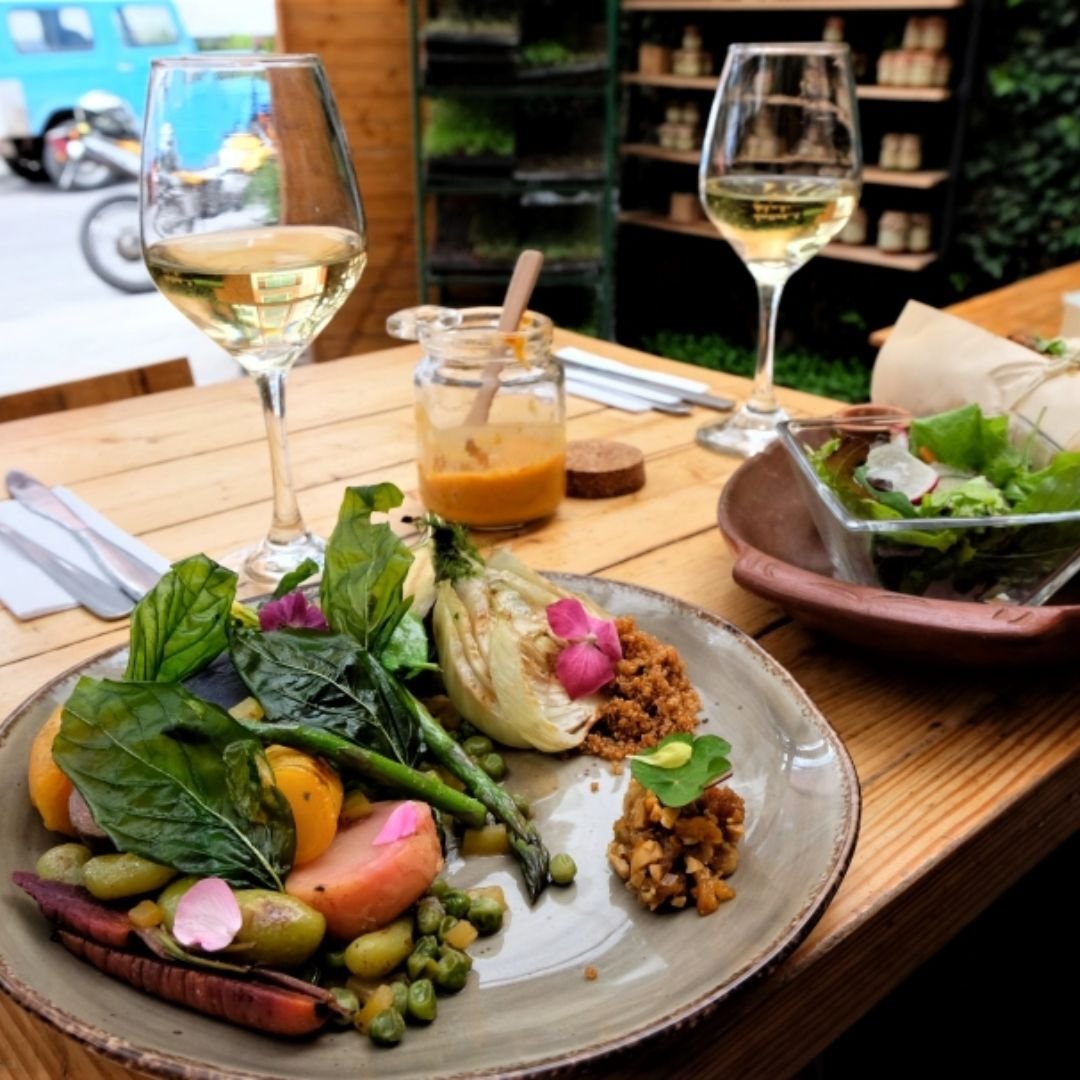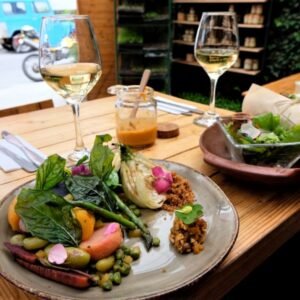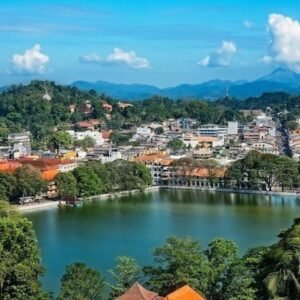By Fathima Rukaiya,
As travel and dining experiences evolve, food-savvy travelers are looking beyond just “fine dining” to experience, local, authentic food cultures.
The 2025 food city rankings reflect that: street stalls and bar tables get equal billing alongside tasting menus. The Readers’ Choice Awards list from Condé Nast Traveler highlights the global destinations where readers felt the most memorable edible experiences.
Let’s walk through the top cities (in the Readers’ Choice list) one by one, then reflect on emerging themes and what this means for your next food trip.
1. Tokyo, Japan

Tokyo claimed the #1 spot in the 2025 Readers’ Choice Awards.
It has a long history of sushi, ramen, tempura, and yakitori, but also creative new-wave concepts using local harvested ingredients, fermentation, and seasonal flavors.
In 2025, Tokyo’s dining is not just about prestige but also small neighborhood spots, late-night yakitori alleys, and market stalls with handmade snacks.
Ultra-premium dining (Michelin-starred, kaiseki, master-chef counters) with flawless street food and izakaya culture.
Cuisines / Dishes:
• Sushi (edomae style) is still the best.
• Ramen: local variations, handmade broths, and unique toppings.
• Modern Japanese fusion, which combines French/Italian methods with Japanese ingredients (such as wagyu, sake, and shellfish)
• Yakitori and grilled small plates in alleyways like Omoide Yokocho and Shinjuku.
2. Santa Fe, New Mexico, USA

This city took second place in the list.
Native American, Hispanic, and Anglo culinary traditions coming together to create a unique American-cuisine hub with a regional touch.
Santa Fe showcases vibrant New Mexican ingredients, such as blue maize, chiles (particularly Hatch and Chimayo), and Pueblo-inspired cuisine.
Handmade breweries, farm-to-table, artisan producers, and chefs elevating local ingredients are all contributing to the growing interest in the restaurant industry.
Cuisines / Dishes:
- Important dishes and cuisines include blue-corn tortillas, green-chile stew, and red-chile enchiladas.
- Modern plating influenced by pueblos, such as squash blossoms, wild mushrooms, and venison.
- Craft spirits: artisan mezcal bars and local mezcal/whiskey-style distillations are starting to appear.
A stronger focus on restaurants run by indigenous people and the preservation of traditional foodways.
Food-festival growth: local produce markets, chile-ripe seasons being celebrated by visitors.
3. Madrid, Spain

Madrid ranks third.
A powerhouse of modern Spanish cuisine while still maintaining traditional hearty fare and tapas bars.
Rising global recognition: the restaurant scene is internationally competitive, but street food and local mercado stalls remain vibrant.
Cuisines / Dishes:
- Tapas culture: jamón ibérico, croquetas, patatas bravas, gambas al ajillo.
- Modern Spanish “tasting-menu” restaurants using local produce (olive oil, saffron, seafood from Galicia).
More plant-based and sustainable-seafood options being woven into menus, even in traditional-style restaurants.
Authentic neighborhood spots are getting rediscovered by travelers who typically seek Michelin lists.
4. Chiang Mai, Thailand
Chiang Mai appears as #4 in the list.

A Thai-culinary gem that combines street-food markets, temple-circuit meals, and emerging fine-dining.
Northern Thai flavours (Lanna cuisine) are getting greater exposure: e.g., khao soi (curried noodle soup), sai ua (herb-sausage), gaeng hang-lay (pork curry).
Chiang Mai has the advantage of being more relaxed than Bangkok, with a deep local-food culture, cafés, and artisan food producers.
Cuisines / Dishes:
- Khao soi (curried coconut noodle soup); signature dish.
- Sai ua (northern-Thai herb sausage), various grilling from street stalls.
- Jungle-herb foraging, local coffee-roasteries, craft breweries.
New high-end restaurants are opening, but they are still affordable compared to mega-cities.
Focus on heritage: local farmers, hill-tribe produce, organic coffee plantations.
5. Quito, Ecuador
Quito lands at #5.

Emerging Latin American culinary destination: blending Andean ingredients, colonial heritage, and modern techniques.
Quito’s rising (Andes) allows for unique produce, from potatoes, native corn, botanicals that chefs are using creatively.
Cuisines / Dishes:
- Ceviche (Ecuador-style, often with Andean twist), locro (potato & cheese soup), empanadas de viento (air-fried cheese empanadas).
- Modern tasting menus re-imagining local fish, quinoa, native tubers.
- Growing international awareness of Ecuadorian cuisine (alongside Peru).
For food travelers: cooking classes, food markets, hidden gems off the main tourist path.
6. Cape Town, South Africa
Cape Town is #6 in the 2025 list.

A vibrant melting-pot of African, Dutch, Malay, and Indian influences, with world-class South African wines, farm-to-table estates and urban food spots.
Cape Town’s food tourism is growing; sunrise markets, Cape Malay flavors, local game meats, coastal seafood, vineyards.
Cuisines / Dishes:
- Braai (South African barbecue) – meats, game, local vibe.
- Cape Malay curries, bobotie (spiced mince dish), rooibos-infused desserts.
- Seafood from the Atlantic & Indian Oceans: snoek, crayfish, abalone.
- Pairing local wines (Stellenbosch, Paarl) with cuisine.
Cape Town offers more budget-friendly, high-quality dining than many European capitals.
7. Lisbon, Portugal
Lisbon is #7.

Lisbon combines traditional Portuguese cuisine with innovative modern restaurants; and all at a more reasonable price point compared with top food-cities.
The city’s markets, cafés, seafood spots, fado dinner-spots all contribute to a warm, vast food experience.
Cuisines / Dishes:
- Pastéis de Nata (custard tarts)
- Bacalhau (salt-cod) in many preparations, fresh sardines grilled during summer.
- Petiscos (Portuguese tapas) + great seafood (clams, octopus, shellfish).
- Modern fusion: young chef-led restaurants using Portuguese ingredients with global technique.
- More rooftop cafés, gastro-markets are emerging, making food hopping easier.
8. San Sebastián, Spain
San Sebastián is ranked #8.

Basque culinary delight: famed for pintxos bars, a high concentration of Michelin-starred restaurants, and a proud tradition of food craftsmanship.
San Sebastián is still a destination for serious foodies in 2025, but there are still plenty of excellent eating options available.
Cuisines / Dishes:
- Pintxos, which are tiny nibbles served in old town pubs on a slice of bread with toothpicks.
- Bay of Biscay seafood, Basque cheeses, and Basque-style beef.
- Foraged mushrooms, cider-paired dishes, and strong local flavors are examples of modern Basque cuisine.
A bit more expensive than some of the other cities but rightly considered a “food pilgrimage”.
9. Palma, Spain (Majorca)
Palma takes the #9 slot.

Located on the Balearic Island of Majorca, Palma mixes Mediterranean seafood, Spanish tapas culture, and island-specific produce (almonds, olives, citrus) with tourist-friendly dining.
In 2025, Palma offers a more relaxed food-trip alternative to the major city hubs, blending beach + flavor
Cuisines / Dishes:
- Seafood: grilled fish, shellfish, paella-style rice dishes taking local twists.
- Tapas bars: local ensaimada (sweet pastry), almond cakes, island wines and olive oils.
- Farm-to-table island produce; citrus, artichokes, local goat cheeses.
- Fine dining venues are increasing, but also strong everyday local pubs.
Food-market culture (weekend markets) expanding for visitors.
A solid destination for those combining holidays + food rather than hardcore food-tour.
10. New York City, USA

NYC rounds out the top ten.
From world-class tasting rooms in Manhattan to hyper-local ethnic communities like Queens and Brooklyn, this global culinary center offers every flavor imaginable.
In 2025, NYC’s food culture emphasizes authenticity, craft, small-plates, and the neighborhood story as much as Michelin ratings.
Cuisines / Dishes:
- New York-style pizza, bagels, deli sausage, and cheesecake are examples of classic cuisines and dishes.
- Ethnic food: Korean fusion, Ethiopian cafés, Burmese Chinese restaurants, and Caribbean cuisine.
- Fine dining and tasting menus: late-night kitchens, chef-owned boutique restaurants, and rising stars.
More chef-driven and pop-up kitchens; fewer “big” restaurants, more flexible and imaginative kinds.
Food walks in the Bronx, Brooklyn, and Queens that highlight meals linked to immigrants are part of the growing food tour culture.
What this Means for Your Trip from Sri Lanka
- From Sri Lanka you might want to pick a destination that aligns with your budget, travel time, and the kind of food-experience you want (street food vs tasting-menu).
- Planning ahead is wise: many of the highly rated restaurants in these cities book out early.
- Consider mixing “big” food cities (Tokyo, NYC, Madrid) with “lesser visited” but top-rated spots (Quito, Santa Fe, Cape Town) depending on your travel style & budget.





